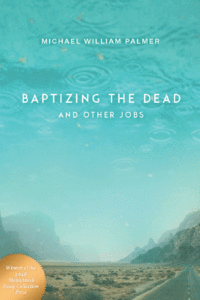 Guest post by Michael William Palmer, the author of the new collection of personal essays, Baptizing the Dead and Other Jobs (Bauhan Publishing).
Guest post by Michael William Palmer, the author of the new collection of personal essays, Baptizing the Dead and Other Jobs (Bauhan Publishing).
Writing about faith is hard, even for those of us who have lost it. There’s a reason missionaries invite potential converts to experience faith through prayer and reflection, rather than pure explanation. When faith really takes over, it reaches deep, and the sensation makes people change their lives. It’s challenging to paraphrase that experience, even if I think the best writing can create a similar feeling for the reader.
It’s also hard to account for the echoing memory of that sensation later. That said, I do think there are advantages to writing about faith from the rearview mirror. I don’t want to overgeneralize a perspective that isn’t mine, but in many ways, I think it’s possible when you have strong faith to take comfort that knowing is enough. The absence of that clear truth makes the need to describe, trace, or characterize a more desperate one.
When it comes to Mormon faith in particular, I also think many writers experience anxiety about representing Mormonism fairly. Out of a desire to avoid exploiting the culture, Mormon writers sometimes sand down any edges that might make Mormonism seem cultish or strange. By coincidence, I went to graduate school with a number of different LDS writers, and many of them were reluctant to talk about their LDS faith directly, preferring to talk about a more universal/general “church” instead. This always frustrated me, in part because ever since I started writing I’ve craved stories about my own people. I wanted the Mormon lexicon to be an asset, rather than a hindrance.
Again, there’s an advantage to being on the outside here, as it makes it quite a bit easier to kick your own people, which can be necessary to get to the heart of the story. But at the same time, as I wrote my book, I started to empathize with my LDS colleagues in that I wouldn’t want someone to read my work and feel smugly superior about their own perspective or culture in comparison. And even if the Mormon lexicon is an asset, it’s hard to know how much backstory is needed to use terms like Adam-Ondi-Ahman or baptisms for the dead with clarity.
All of this without even getting into the challenge of describing Utah itself. Nothing has formed me more than the mountains that surrounded me where I grew up. How do you describe Timpanogos to someone who isn’t used to it?
It’s not like I figured all those challenges out while writing Baptizing the Dead. Indeed, I think some part of the book is about the grapple between being true to the texture of Utah County Mormonism, a small corner of lived experience, while also wanting to resonate with a reader unfamiliar with that corner. But here are four texts that offered some insight into the above tensions, and gave me ideas for my own work.
(It stands out to me how white the list is. I think that’s a double blindspot—my own, certainly, but also a broader issue in Mormon literature, as well. Hopefully we can improve on both going forward.)
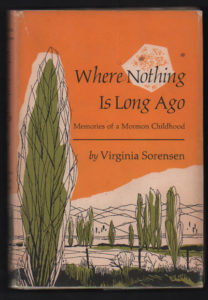 Where Nothing Is Long Ago by Virginia Sorensen
Where Nothing Is Long Ago by Virginia Sorensen
In my view, Sorensen is the Mormon GOAT. This book blew my mind in college and it’s just as good now.
This will take a minute to tie back, but it relates: Earlier this year, my family discovered a letter from an ancestor. It was written by Lucy Woffinden Poulson—my great-grandmother. She wrote the letter in 1930, intending for her descendants to open it up 50 years later, in 1980. But it got lost and forgotten in a filing cabinet before being discovered this year.
It’s an amazing letter and time capsule. She talks about moving to Utah from England as a child in 1888 after her family joined the LDS Church. She gets married to a railroad man at age 20. They move from Pleasant Grove to Ironton, and eventually to the Provo bench. She had nine children, two of whom died—one as an infant, and one as a teenager who drowned in Utah Lake.
The story is generous, both heartwarming and heartbreaking. I’m so grateful it was found, and I’m certainly not out here to criticize my great-grandmother’s writing style. But what she doesn’t talk about is any detail of landscape. I’ve always wanted to picture what Utah County was like in those early settler days or before. My great-grandmother gave me a clear idea of what happened in her life, but no sense of what is looked/smelled/sounded like.
Sorensen’s gift is that she does exactly that. She provides the texture and sensory detail of that time and place. Anybody from Utah would immediately recognize her descriptions of Timpanogos or Spanish Fork Canyon, but even without any shared familiarity, Sorensen does an incredible job of transporting the reader to that landscape through her sentences.
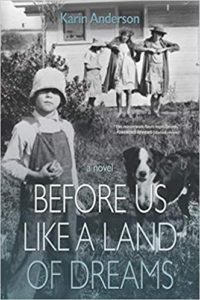 Before Us Like a Land of Dreams by Karin Anderson
Before Us Like a Land of Dreams by Karin Anderson
I would read Anderson’s sentences about any topic, but this book is a particular gift because she brings to life the parts of pioneer stories that tend to get a two-sentence gloss in the official version, which can leave a reader like me shaking the page wanting more. A lot of pioneer stories are like that—a flash of a mysterious adoption, the loss of a farm, or a character’s reappearance after vanishing five years ago. Anderson’s book picks up in those gaps. She recreates the time without erasing the characters or details that the official narrative didn’t know what to do with. In her book breach, Anderson explores her complicated, at times quite harrowing relationship with the Mormon Church. But many of the characters in Before Us Like a Land of Dreams are faithful. In this way, Anderson writes about faith from the rearview mirror by re-inhabiting the feeling through her characters.
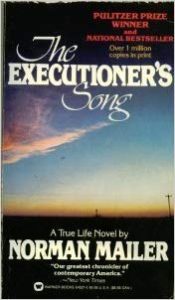 The Executioner’s Song by Norman Mailer
The Executioner’s Song by Norman Mailer
This is a well-known book, but I think it’s particularly valuable from a Utah County perspective. For one thing, when I was a very young writer, the fact that the book took place in my home region and was still considered important enough to win a Pulitzer Prize was noteworthy. And then when I picked it up, it transformed my home through defamiliarization. I was so used to Utah County the way I’d always seen it. The orchards, the freeway, the church steeples and mountain peaks pointing up. It took another perspective to re-focus my eyes on the spine of State Street, with all its garish grit, running underneath that gorgeous mountain range. My wife, a Texan, read this book before visiting Utah for the first time—and she remains obsessed with State Street, which she calls “Utah’s Sunset Boulevard,” to this day. Mailer’s Utah County is not as lush as Sorensen’s, but it’s still breathtaking in its way.
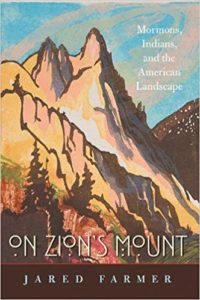 On Zion’s Mount by Jared Farmer
On Zion’s Mount by Jared Farmer
The narrative I was told about my home region of Utah Valley was that it was once a desolate, unwanted area, made good by the pioneers—as if the salt flats used to cover the entire state. In that narrative, the human history basically starts in the 19th Century. Farmer—a historian—blows all of that up. He shows that the region was extraordinarily beloved and protected, in part because of its initial magic: Utah Lake. Since polluting the lake with agricultural runoff, and then steel mill refuse, our attention has turned exclusively to the mountains. I’m still learning more about what life was like in the region before the Mormons showed up, but Farmer opened that door for me.
There are any number of books that could be added to the list that have been formative for me—Refuge, Altmann’s Tongue, Educated, etc.—but these four were instrumental in teaching me how to write about place, faith, and history. They taught me that I had a right to my own stories, and that those stories could speak to a lived experience beyond Utah’s borders.
Winner of the Monadnock Essay Collection Prize, Baptizing the Dead and Other Jobs tells a coming of age story set in the heart of Mormon Country: Utah County, Utah. These essays weave together a timeline of salt flats grit and labor—7/11 clerk, telemarketer, custodian, and more—to explore deeper questions of how to be of a place, and how to quit it. A meditation on lost faith, lost friends, and the longing for familiar landscapes and rituals that bind us to ourselves and one another, this collection is a love song to the American West, and a farewell.
“I was struck from the first sentence by the crystalline narrative voice—sometimes uncanny, sometimes weird, but always precise, unflinching, and painfully self-aware—and the experimentation with form as a way to dig deeper and question ideas of religion, family, place, community, masculinity, death, and the self. These essays, and their narrator, wouldn’t shake from me after I read them. I wholeheartedly recommend Baptizing the Dead and Other Jobs.” —Anne Barngrover, Monadnock Essay Collection Prize judge, and author of Brazen Creature
Baptizing the Dead and Other Jobs is not about Mormonism. It’s about the human condition, and the brilliant nonfiction writer Michael Palmer has nailed it in this collection. The first and last essays are masterpieces of the current form. It’s a mix of the traditional and the experimental, exactly what American literature has been since its beginning. Nothing is predictable in this book. That’s why it’s nothing less than art—Dennis Covington, author of Salvation on Sand Mountain
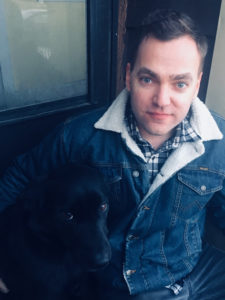 MICHAEL WILLIAM PALMER’s work has appeared in Bellingham Review, CutBank, Georgetown Review, The Collagist, Alligator Juniper, West Texas Literary Review, and numerous other publications. He received his PhD in English-Creative Writing from Texas Tech University. He grew up in Utah and currently lives in Forest Park, Illinois. Baptizing the Dead and Other Jobs is his first book.
MICHAEL WILLIAM PALMER’s work has appeared in Bellingham Review, CutBank, Georgetown Review, The Collagist, Alligator Juniper, West Texas Literary Review, and numerous other publications. He received his PhD in English-Creative Writing from Texas Tech University. He grew up in Utah and currently lives in Forest Park, Illinois. Baptizing the Dead and Other Jobs is his first book.
